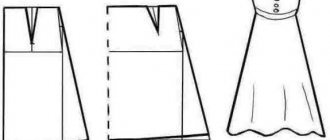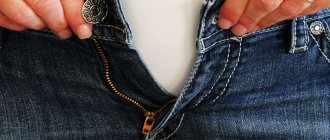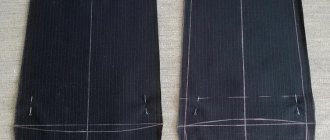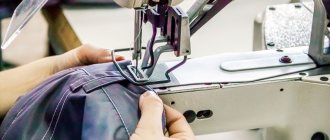Every person knows about the ability of jeans to change size over time. It happens that jeans fit perfectly when you try them on in the booth, but after a short wear they stretch out a lot. In addition, many women buy clothes that are slightly inappropriate in size with the intention of losing weight, but this does not always work out. Obviously, it’s stupid to throw away almost new jeans; it’s better to get them tailored to your figure.
How to properly sew in the sides of men's and women's jeans
If it turns out that the new trousers do not fit well, and the old ones have become too big, then it becomes necessary to sew in the sides of the jeans at home.
Often people make purchases in a hurry and only later notice that the item is partly out of size. In such cases, it is quite possible to adjust the purchased jeans to your figure and height at home. This can be done by any craftswoman with minimal sewing skills.
It is more difficult to make jeans smaller than regular trousers, although the repair technology is the same.
To facilitate the work process, you will need knowledge of the features of denim material:
- the finishing stitches are made with a contrasting color thread, it will be difficult to choose the right texture and color;
- not all home sewing machines can sew thick thick fabric, so in difficult places you will have to sew by hand;
- It’s wiser to imitate a complex denim seam;
- Jeans should only be reduced by 1-2 sizes for the sewing to be successful.
Now, if you have free time, a sewing machine and the necessary tools (sharp scissors, color-matched threads, tailor's pins, a tape measure, an iron), then you can start working.
How to sew in jeans that are too big on the sides:
- Put your trousers on inside out and pin the areas that are too big with safety pins. Do this on both legs from the inside and outside.
- Remove the trousers, lay them out on a smooth surface, and level them well with your hands. Using chalk, mark a straight line along which the stitching will run. Leave an allowance of 1.5-2 cm for shrinkage. If the material stretches, then there is no need to leave additional centimeters.
- Make a mark along the marked line.
- Try on and make sure that the pants fit and do not restrict movement.
- Trim off excess material by 1-1.5 cm from the hand seam.
- Sew the product using a machine, finishing the edge with a zigzag stitch or using an overlocker.
All you have to do is use the iron and your favorite item will fit perfectly.
On a note! You cannot sew the pants only at the side seams, otherwise they will look twisted. Sometimes metal rivets interfere with the movement of the working needle; they must first be removed.
This is interesting: Jeans for obese women (65 photos): how to choose, what to wear with
How to sew jeans in the legs without a machine
If the jeans have stretched during wear, you can return them to their original appearance and fit them to your figure without a sewing machine. In this case, the problem can be eliminated by washing. This method is effective if the cotton content of the fabric is at least 70%.
Important! When exposed to hot water (80-90 degrees), denim shrinks, so the product decreases in size.
Main options for the procedure:
- Machine washable. Load jeans into drum. Set the water heating to 90 degrees, and also select the maximum number of revolutions. To eliminate the possibility of changing the shade of the fabric, you should not add washing powder. If there is a “Hot Dry” function, install it, as this also promotes shrinkage.
- Wash by hand. Pour hot water into a basin so that its volume completely covers the jeans. Soak the trousers and leave them like that for 20-30 minutes. To consolidate the shrinkage effect, it is recommended to carry out a contrast rinse several times, using alternately hot and cold water.
- Boiling. Fill a large saucepan with water and immerse your jeans in it. Place the container on the stove, turn on the heat and bring to a boil. Boil the trousers for 30 minutes, remove and leave to cool. Only then rinse. This method allows you to dramatically reduce the size of jeans, but it can only be used on white trousers, as the shade may noticeably lighten. It is also not suitable for products with decorative finishes, which may peel off or become deformed when exposed to hot water.
Important! You only need to wash your jeans on a hard cycle occasionally, as frequent use will cause the fabric to wear out quickly.
Methods of suturing
You can make your jeans fashionable and fit them to your figure yourself. Having carefully studied all the possible ways to sew in jeans and selected the right tool, you can get to work.
On the sides
You can quickly and efficiently sew jeans along the side seams by following a certain algorithm of actions:
- Turn the trousers inside out, put them on, and pin the places that need to be sewn together. Don't forget to leave a few centimeters of fabric for seam allowance;
- Take off your jeans and draw a seam line with chalk along the pins. Baste with thread. Craftsmen recommend trying on trousers with basting again so that, if necessary, you can adjust the seam line;
- we sew the basting or sew it by hand;
- trying on jeans again. If there is no feeling of constraint, the trousers fit perfectly in the hips, you can proceed to the final stage of work;
- We cut off the remaining fabric, not forgetting to leave a few centimeters for allowances;
- overcast or machine the edges of the denim and sew a second line.
When sewing jeans in the legs, the main thing is the correct measurements.
Turn the jeans inside out and put them on
We chop off in places where it is necessary to suture
At the waist
Those with an ideal thin waist and rounded hips are familiar with the problem of jeans that are wide at the waist. It's easy to solve. All you need is patience, needles and threads (or better yet, a sewing machine), and follow a clear algorithm of actions.
The first option for sewing jeans wide is simple:
- along the belt line we mark several darts;
- in the marked places, carefully rip off the belt (2-3 cm);
- sew the darts by hand or using a sewing machine;
- cut off excess denim fabric;
- sew on the belt.
When creating darts in the buttocks area, you need to be extremely careful. Long seams will pull up the fabric and the jeans won't fit as well as they should.
The second method, how to sew jeans at home at the waist, requires more time, effort and patience:
- Carefully rip off the belt loop located in the center of the back of the belt. If a company label is sewn in this place, it is also removed;
- rip the belt ten centimeters to the right and left from the middle seam of the trousers;
- carefully rip out the crotch seam by eight centimeters;
- We iron all the torn areas thoroughly, remove excess threads;
- We fix the middle seam with pins (helps to avoid displacement of the fabric);
- we turn the two trouser legs inside out, place them on top of each other and draw a new seam line at a distance of two centimeters;
- we sew new markings, we process the edges by machine or by hand;
- turn the jeans outside and sew two central lines;
- We attach the belt to the jeans, trim off the excess fabric and stitch it;
- Additionally, we fasten the opened belt loop with pins and make a second line;
- The bottom edge of the product must be hemmed by hand or stitched on a machine.
Tapering to the bottom
You can taper jeans at the bottom using the technique of tapering the product on the sides, described earlier. But there is another way to sew jeans in the legs, allowing you to quickly and effortlessly get the desired result.
Before you begin, you need to prepare jeans that fit your figure perfectly. Pants that require adjustment are turned inside out and jeans of a narrower model are pinned onto them. Two pairs of trousers are pinned together, after which a new seam line can be marked. A seam is made using a machine or by hand (which is much longer and more difficult) according to the markings. The excess fabric of the trousers is cut off and the edges are overcast.
The technique of using a second pair of trousers in order to narrow the jeans towards the bottom helps to significantly reduce the time spent on fitting. If you need to narrow the bottom of several pairs of jeans, you can remove the pattern from the “correct” model and use it as a pattern.
Changing the flare into a narrow model
Very often, some jeans models become a thing of the past, and new styles come to replace them. More recently, every fashionista had flared jeans in her wardrobe, but now they have been replaced by skinny models. Don't part with your favorite jeans, because they can be altered.
To sew jeans in the legs, you need to do the following:
- Turn the jeans inside out and try them on.
- Use pins to mark a line for a new seam, but you need to take into account one centimeter, which will be used to shrink the product after washing.
- Jeans must be removed, laid out on a horizontal surface and opened from the knee downwards.
- Carefully make throwing seams along the line marked with pins and put them on again for fitting.
- Cut off the extra centimeters of fabric.
- Use a sewing machine to make strong metal seams.
- You can use a zigzag or overlock to finish the edges.
It is quite possible to adjust jeans to your figure after they suddenly become too big due to a diet, or to adjust the model of new trousers if trying them on at home showed that they do not fit perfectly. But in order to do the job efficiently, you need to know how to properly sew jeans along the side seams, and what is required for this. Therefore, it is worth considering all possible options and choosing the most suitable one depending on the capabilities and situation.
Suturing locally
If your jeans look great on you but are a little big in the waistband, sewing them in along the back seam and waist can help remedy the situation.
If your favorite model has become a little loose, then it is worth stitching only along the side seams. To create a tapered hem, you should sew the jeans along the inside seams.
At the waist
Many girls have wide hips and small waists, so any pair of jeans will be loose in the waist. To solve this problem, jeans should be sewn in one of two ways.
The first method is the simplest:
- First you need to make several darts along the belt line.
- Next, you need to carefully rip off a few centimeters of the belt.
- Carefully stitch all darts.
- Cut off the extra centimeters on the belt, and then sew it back.
- You must be extremely careful when creating a dart in the buttock area, as very long seams will pull them up.
The second method is more complex, but of high quality:
- First you need to undo the belt loop, which is located in the back center. In some models, it is necessary to remove three belt loops at once. If the branded label is located nearby, it should also be removed.
- Carefully open the waistband, but only ten centimeters to the left and right of the middle seam of the product.
- Then you need to pay attention to the crotch seam and space it out by eight or nine centimeters.
- Remaining threads should be removed and all seams should be ironed thoroughly.
- The middle seam must be secured on the front side with pins to avoid possible displacement. Next, transfer the fastening with pins to the wrong side and steam with an iron.
- Fold the trouser legs together and draw a line at a slight angle at a distance of about two centimeters.
- The drawn line must be stitched and the edges of the fabric overcast.
- Next, turn the jeans right side out and make two lines in the center.
- Go to the wrong side again to sew up the crotch seam, and finish the double stitch on the front side.
- The belt must be applied to the new waist size and the extra centimeters must be trimmed, but remember the allowances.
- Next, the product must be folded in half, right sides inward, stitched and unfolded before ironing.
- Fasten the belt and the main part of the product with pins and sew the belt loop back.
In the hips
To reduce the size of jeans at the hips, you should sew them in at the side seams.
To calculate the distance that needs to be removed, you can use one of the following methods:
- Turn the jeans inside out and put them on. Use pins to mark the new seam.
- Take the trousers that suit your figure, attach the ones you want to sew in and draw a line.
The process of reducing the volume of pants in the hips occurs in several stages:
- First you need to undo the belt.
- Next, rip the legs apart at the sides and stitch them along the new seams.
- Cut off excess material and sew down the sides.
- Sew the belt into place.
If the jeans are spacious in the hips and waist, then the belt should not be steamed. The trouser legs must be completely ripped open and carefully sewn to the new dimensions.
For thin denim jeans, you can make darts on the sides, then the model will fit better.
1
Sewing equipment
Sometimes a new item, when trying on at home, turns out to be the wrong size or does not fit perfectly. This happens because factories sew products according to certain measurements, which not every figure corresponds to. Therefore, a new item may have fit defects and may not look beautiful enough. This does not mean that you bought defective clothes, just that your parameters do not correspond to the standard ones.
If the item doesn’t fit or you suddenly lost weight, but don’t want to part with your favorite jeans, you can “adjust” them to your figure yourself, even without special skills. To sew jeans at home, you will need:
- sewing machine or set of needles for hand sewing;
- measuring tape and ruler;
- seam ripper (can be replaced with a stationery knife or nail scissors);
- scissors;
- threads to match the fabric and finishing stitching;
- chalk or soap;
- tailor's pins;
- iron.
How to starch a shirt at home - step-by-step instructions
Changing the flare into a narrow model
Very often, some jeans models become a thing of the past, and new styles come to replace them. More recently, every fashionista had flared jeans in her wardrobe, but now they have been replaced by skinny models. Don't part with your favorite jeans, because they can be altered.
To sew jeans in the legs, you need to do the following:
- Turn the jeans inside out and try them on.
- Use pins to mark a line for a new seam, but you need to take into account one centimeter, which will be used to shrink the product after washing.
- Jeans must be removed, laid out on a horizontal surface and opened from the knee downwards.
- Carefully make throwing seams along the line marked with pins and put them on again for fitting.
- Cut off the extra centimeters of fabric.
- Use a sewing machine to make strong metal seams.
- You can use a zigzag or overlock to finish the edges.
join the discussion
Share with your friends
Jeans are sewn according to established standards, so they look less attractive on girls with imperfect figures. Although there are separate collections for girls with non-standard figures, this cannot solve the problem completely.
If your figure deviates only slightly from the generally accepted parameters, then you can purchase your favorite jeans model and trim it a little. This process is quite simple, so you can do it yourself at home.
How much can you reduce
Even the best quality jeans lose their shape and stretch as they wear them. This is absolutely no reason to rush to turn them into lounge pants. Any denim item in your wardrobe can be made smaller by a size or even two without any problems. All that is required for this is to prepare the necessary tools and stock up on time and patience.
You can reduce your jeans size yourself
This is interesting: Boyfriend jeans: 50 photos, what they are, for women
3
Sizing
To determine sizes, there are standards that guide clothing industry enterprises. Those who know how to sew at least a little know that every centimeter of volume changes size. If your jeans are 1-2 cm behind at the waist or hips, then you will have to sew them up 1 size, from 2 to 4 cm - two sizes. It's worth remembering these numbers. Firstly, it will help when choosing the next new thing in the store; secondly, you can find a thing in your wardrobe that is 1-2 sizes smaller and use it as a pattern. On the wrong side of the jeans, you can apply a similar model that suits your size, and then mark new seams along the contour of the product that fits well on your figure. To prevent the chalk line from being erased during work, you can lay a basting line along it.
An item one size smaller can serve as a pattern
The best ways to stretch wool that has shrunk after washing
How to make pants a size smaller
You can solve the problem of jeans that are the wrong size by applying a few simple methods in practice:
- washing at high temperatures is the simplest and most effective method for reducing jeans size. The washing machine is set to the washing mode at 95 C. Place the trousers in the washing machine and spin the clothes in this mode for at least thirty minutes. The rinse mode must be turned off;
- drying on a hot radiator. Washed jeans are laid out on a hot radiator to dry or the product is dried using a steam dryer;
- shock therapy method. Prepare two containers: one with very hot water, the other with cold. Dip denim trousers first into a basin of boiling water (hold for at least ten minutes), and then abruptly into a basin of cold water. Such manipulations must be repeated two or three times. Afterwards the jeans are thoroughly wrung out and dried.
When using the technique of quickly shrinking a denim product, the main thing is not to overdo it. Otherwise, it will be impossible to wear jeans.
Making pants one size smaller without using needles and threads will most likely work for a short time. Within a week, the jeans can stretch back to their original size. The problem of size mismatch can be corrected qualitatively and permanently only by suturing them.
Some nuances of working with jeans
Denim is a very practical, wear-resistant and comfortable material. It’s not for nothing that things made from it are very popular. If you need to remake denim pants or shorts, you will have to take into account some of the features of this fabric.
Thin, soft jeans, also called “lightweight,” can be sewn by hand (if you know the appropriate seam technique), but thick denim or lined fabric will have to be sewn together exclusively by mechanization.
Jeans shrink a lot after washing. This means that it cannot be kept in hot water (more than 45 degrees). You also need to take into account future “shrinkage” when altering clothes. By shrinking your jeans too much, you run the risk of not fitting into them after the first contact of the clothing item with water.
5
Belt reduction
An incorrect fit at the waist spoils the appearance and makes it uncomfortable to wear. Jeans can be sewn along the middle back seam. To make the markings, you will need an assistant. It will be difficult to mark the seam line on your own during fitting. But you can do it another way: use a model that fits you perfectly as a pattern.
Step-by-step instructions for reducing the waist of jeans:
- we chop off the excess during fitting, carefully remove the trousers and mark the lines of the new seam;
- we rip out the part of the seam that connects the middle seams of the back part and the waistband;
- unpick the middle back seam;
- along the marked lines we lay a line that will connect the back halves;
- iron the seam;
- cut off the excess and process the cuts using an overlocker or machine;
- on the halves of the belt we measure on both sides the amount by which we will reduce it;
- we sew the halves of the belt by machine;
- iron;
- sew the belt along the top edge to the jeans;
- On the front side we lay a finishing stitch to match the factory finish.
This method is suitable if you need to reduce the model by 1-2 sizes. If the volume is larger, it is recommended to make reductions along the side seams.
6
Additional darts
If you need to sew down jeans by 1-2 sizes, you can make darts on the back halves. We do it like this:
- tear off the belt;
- mark the dart lines, symmetrically on both sides;
- from the middle seam in both directions we set aside 9-12 cm and build vertical lines (the height of the dart should be no more than 6 cm and the depth no more than 1.5 cm);
- make a seam along the marked lines;
- iron;
- we reduce the length of the belt by the solution of darts (if you made two darts with a depth of 1.5 cm each, then the belt needs to be reduced by 3 cm);
- sew on the belt.
insert photo with darts
All operations should be done carefully. In some models, you will have to undo the belt loops and then return them to their place. After marking, it is advisable to sweep away the seam lines and try them on to make sure everything is done correctly. If using these simple methods you cannot achieve a good fit, you can contact a studio. Aligning the crotch (inside) seam requires some skill.
Reducing stretched jeans at home is easy. If you want to make a model for yourself out of very large trousers, then you will have to completely rip the product apart and cut out new parts from it. Other jeans that fit perfectly on your figure can serve as a pattern.
How to sew a jeans waistband using the side seams
It is relatively easy to sew in trousers that are wide at the waist by removing excess fabric from the sides. However, it is worth immediately making a reservation that it will not be possible to sew in any product by more than 1-2 sizes using this method, due to the presence of pockets that can shift and visually disrupt the proportions.
To work, you will need the same set of sewing tools and materials as in the methods of sewing jeans described above.
The sequence of actions in this case will be as follows:
- You need to rip the side seams 25-27 cm down from the waist and part of the belt, approximately 10 cm in each direction from the side seam.
- Next, draw a new one along the side seam on the back halves of the trousers. It is important here not to take more than 3 cm from the side stitching so that the pockets remain in place.
- Sew the halves of the trouser legs, aligning the seams in a new way, trim off the excess fabric and overcast the edges.
- After this, all that remains is to lay a finishing stitch along the front side and stitch the reduced belt in place.
It is better to cut and remove the excess length of the belt in the places where the belt loops are sewn on, so that, as in the case of reducing jeans along the back seam, they hide the place of sewing.
Necessary materials
For work you may need:
- tailor's pins (with a head or an eye);
- pencil, soap or chalk;
- centimeter;
- long ruler;
- sewing needles;
- threads to match the color of jeans and suture threads;
- iron or steamer;
- sewing machine;
- scissors;
- thick elastic band.
If everything is available, get to work.
Big jeans have no place in the closet - sew them in and keep wearing them
The girl showed how to fit jeans to your figure. Need a shoe lace
Sometimes it happens that jeans do not fit too tightly to the waist. That's why one creative girl decided to share her advice on tailoring an outfit to your figure. To do this, she took a simple lace and placed it in a special way. Minimum time - and excellent results. But her video divided users into two camps. What is the problem?
Suturing in the waist area
To reduce the size of the product in the belt, three options are offered.
With the help of darts
The method is labor-intensive, but effective; it will help to sew in jeans by 5-7 cm.
Need to:
- Open the waistband between the back side seams.
- Turn the product inside out and put it on.
- Pin the back darts with pins according to the figure at the same distance from the middle seam.
- Take off your pants, draw a line and mark them according to the marks.
- Iron.
- Choose the appropriate thread color.
- Sew using a machine.
- Undo the middle belt loop.
- Cut off excess fabric from the waistband, sew it and sew it onto the jeans.
- Sew a belt loop in the middle and iron the product.
This option involves working with darts at the back, but there are other options. You can make darts on the sides. Here it is sutured on both sides - step-by-step (internal) and (lateral) external. It is sutured from the side when it is necessary to remove excess only in the femoral area.
Suturing at the seams
It is allowed to sew both one back seam and two side seams.
Working with side seams:
- Open the belt to the right and left, no more than three centimeters to the right and left of the seam.
- Open the seams themselves from both sides to the thigh.
- Select the protruding threads.
- Turn the pants inside out and put them on.
- Reduce the required amount of fabric and secure the selected position with pins.
- Draw a straight line and baste along it.
- Iron.
- Place the second leg on the treated one and transfer the measurements.
- Try it on again. If everything is satisfactory, trim off the excess material.
- Finish the edges of the cut.
- Machine stitch the seam.
- Steam the product.
If you need to remove an extra couple of centimeters, you can simply sew along the middle seam at the back. The procedure is practically no different from the previous one, only the stripping of the belt is carried out in a different place. You will also have to remove the belt loop for a while. Only one seam is unraveled, which simplifies the procedure.
You might be interested in: 7 ways to hem jeans
Using an elastic band
Reducing by inserting an elastic band will help if the product is no more than 3 cm large.
You should proceed step by step:
- Measure your waist circumference with a measuring tape.
- Cut the elastic 5-7 cm shorter than the resulting number, because after stretching the desired size will come out.
- Make 2 cuts in the waistband of the trousers from the inside out.
- Place a safety pin through the elastic.
- Pull it into the belt and sew it to it.
- Try on the item - it's ready.
If you choose the right elastic band, your jeans will fit perfectly. Here you can get by without a sewing machine, if you don’t have one.
Important! Buy a thick and wide elastic band; a thin and weak one will not hold such a hard and heavy material.
Work algorithm
- Several darts are marked in the waistband area, which are then carefully torn off.
- Next, the darts are stitched (by hand or with a machine).
- The remaining material is cut off and the belt is sewn back.
Narrowing at the waist
It is worth remembering that if you have any doubts about working with clothes yourself, you can always contact a tailor. There, wide trousers will lead to the desired style quickly and efficiently. In some cases this is indeed the right decision. For example, this applies to very expensive things that you don’t want to ruin when sewing. Prices in the studio vary depending on the city and prestige. Typically, the service of sewing up trousers costs the client 400-600 rubles.* It all also depends on where the excess fabric needs to be removed. You can contact the studio if you don’t have an overlocker or machine at home - processing will cost 50 rubles/m.
Along the side seams
Stitching along the side seams is used when the trouser legs are wide at the very bottom, at the calves and slightly above. Typically, flared trousers that do not like the shape, and trousers that do not fit, are processed.
You might be interested in Sewing skirts and dresses with and without patterns
How to sew jeans in the legs - the following algorithm will tell you:
- How to narrow jeans at the bottom at home?
- First, you need to try on the jeans to understand where to sew them in and how much. Selected places are secured with pins.
- It’s worth checking again before altering how the item fits your figure.
- Place the jeans on a hard, flat surface and straighten them well so that there are no creases left anywhere.
- Using a bar of soap, draw a line for the future seam at the place where the pins are attached.
- Threads are used to sweep away excess fabric onto items.
Sewing flared trousers
- The pants are tried on again to check for any flaws. It is worth noting that if the jeans are long, they are first shortened to the desired size (but not stitched), and only then the excess is removed from the sides.
- Excess fabric is cut off, leaving an allowance of 1-2.5 cm.
- Then the edges are processed using an overlock or zigzag stitch. The thread is selected according to the shade of the jeans. Edge processing is necessary because... cut fabric quickly deteriorates and crumbles.
- After processing, they begin to sew new seams, carefully connecting them with the old ones.
- The product is ironed and tried on.
If there are no flaws, excess threads are removed.
Tapering the pants at the sides
Topstitching
Stitching is done to give new jeans a finished look. It is needed so that the inner seam does not look too clumsy.
Topstitching
- You need to take threads that match the color of the existing stitching.
- An approximate seam is applied, simulating a factory one.
- The thing is ironed. At this stage, the bottom of the trouser legs is folded and stitched.
To make the stitching look neat, it is recommended to take thick threads or connect 2 thin ones. It is allowed to use black threads in the place of the shuttle.
Sewing a new stitch
Suturing in the thigh area
If the pants are wide at the top of the legs, it is advisable to sew along the side seam.
For this:
- Put on your pants with the inside out.
- Mark with pins how much fabric needs to be removed.
- Remove the product, draw lines under the ruler with a pencil (chalk or soap).
- Open the belt and pockets.
- Open the side seams.
- Baste new ones along the lines.
- Using a machine, stitch along the marks from the inside and make 2 lines from the face.
- Be sure to overlock the edges and iron the product.
If the measurements are taken correctly, the pants will fit correctly.
Advantages of ordering
Our company includes a whole staff of highly qualified craftsmen. It is profitable to cooperate with us! Firstly, we have new equipment and trained personnel. There are several fashion designers on staff who can give competent advice on style. As for the timing, it all depends on the complexity of the repair. Minor repairs are carried out in fifteen minutes; if the work involves re-cutting, the client will have to wait a little. In any case, the quality and timing of the work will satisfy the customer.
All our prices for jeans repair are listed on the website. Clients will appreciate low prices for services.
At the first contact, the client just needs to voice his requirements, show the places in need of repair, the craftsmen will immediately assess the amount of work and determine the prices.
Useful tips
When using life hacks that will help you sew jeans into a waistband, it is important to take into account the rules for high-quality processing of the product:
- Jeans that need to be sewn in at the waist should go through at least one wash, which will help avoid shrinkage after alterations.
- Trying needs to be done several times. This will allow you to more accurately achieve the desired size.
- To sew up your favorite wardrobe item, you can use a template in the form of old, narrower pants.
- You should avoid completely ripping apart the legs, since it is almost impossible to sew the crotch area yourself at home.
- The threads must be strong so that the tapered jeans do not come apart at the most inopportune moment.
- The edges of the cuts must be carefully processed using an overlocker or by hand overcasting.
Stitching in the hips
Another home-made way to sew in jeans at the waist without resorting to the services of professionals is to reduce them at the sides.
Before starting work, the product must be thoroughly washed and ironed, regardless of whether the item of clothing is being remade, old or new.
The algorithm of actions should be approximately as follows:
When sewing jeans, you must try them on inside out.
- Turn your pants inside out.
- Try them on like this.
- Use pins to mark the places where the side of the product should be reduced in volume.
- Take off your jeans and carefully lay them out on any horizontal surface.
- Using chalk, draw a line along the pins where the seam will run.
- Hand sew the jeans along the marked lines.
- Turn the pants right side out and try them on. An important condition: you must try to sit down.
- If no discomfort is felt, you can continue working.
- Open the waistband at the bottom and the side waistband.
- Trim off excess fabric, leaving 1.5 cm for seam allowance.
- Sew jeans.
- Finish the edge (overlock or zigzag).
- Use a steamer to smooth the side edges.
- Finish along the side seam using contrasting threads.
- Remove extra centimeters from the waistband.
- Sew the previously opened area.
- Iron the product completely.
- Carry out similar actions on the other side.
- Finally try on the product.
How to change your jeans size
- If your jeans are too big, turn them inside out and wash them in cold water. Moreover, the water should be ice-cold. Next, the pants are thrown into the dryer and the maximum temperature setting is set. Drying should take at least an hour. By trying on the jeans after finishing, you can make sure that they have decreased in size. By the way, you can repeat the operation several times.
- Short jeans need stretching. It is advisable to involve an assistant in the stretching process. One person grabs the ends of one of the trouser legs, the other - the waistband of the trousers. They should stand opposite each other and gently pull the jeans to their sides. This continues for 2-3 minutes, you need to pull strongly and carefully at the same time. Then it’s time to carry out similar manipulations with the second leg.
It happens that the pants are tight in the hips or waist, then it is better to resort to another stretching method. The denim product is put on and fastened. Then you need to spread your legs wide and do leisurely squats. In this case, you should control the straight position of your back and perform the exercises as carefully as possible. For stretching jeans in the waist area, bending forward is more suitable, of course, also carefully and slowly. The procedure is repeated until the desired result is achieved.
There is a point in artificially stretching jeans if a person feels uncomfortable in them. If he can't even button his pants, it's better to just buy other clothes.
Clothes that suit your figure: stylish and neat
Jeans are one of the favorite things of the entire beautiful (and not only) half of humanity, and all because they are practical, fashionable and perfectly emphasize the advantages of the silhouette. But at the same time, they have one drawback - all models are sewn, as they say, with the same brush, i.e. according to standard body shape standards. To correct this injustice, you just need to sew up your favorite jeans in some places. To do this you will need a little patience, determination and a sewing machine at hand.
Problem 1. How to sew jeans in at the waist?
In order to make jeans one size smaller at the waist, you need to prepare a tape measure, scissors, tailor's pins (sold at any sewing store), a sewing machine and thread to match the material. There are two ways to sew jeans in at the waist - simple and more complicated. We'll look at both.
The simplest thing is to adjust the trousers to your figure using darts . The step-by-step instructions are as follows:
1. Put on jeans and visually mark the places where the darts will be less noticeable (as a rule, they are made on the back of the product in the buttocks area). You should also determine how many centimeters the jeans will need to be sewn in at the waist.
2. Now open a few centimeters in the waistband in the places where the future darts will be.
3. Baste the undercuts. Try on your jeans again. If there are enough decreases in the waistband, you can machine stitch the darts.
4. Now you need to sew in the belt. To do this, carefully cut off the extra centimeters of material and carefully stitch the sections with a machine stitch, having previously swept them by hand.
Advice! Do not make the darts in the waistband too long - this will cause the entire product to “bounce” upward in the buttock area.
The second way is to sew the jeans along the central back seam :
1. The first thing you need to do to fit the product is to undo the belt loops , which are located near the back center seam. This also applies to the branded label, if it is also sewn very close.
2. Now you need to open the waistband ten centimeters on either side of the center. The middle seam also needs to be split eight to ten centimeters down. Remove the remaining threads and secure the spacers. Do this carefully so you don't have to do a lot of corrections later.
3. Iron everything thoroughly.
4. Now turn the garment inside out and fold the legs so that the middle seam is facing you. Secure both halves of the jeans with tailor's pins to prevent movement.
5. The most crucial moment has come - you need to draw the line of the future middle seam . To avoid mistakes, draw it as follows: first, mark in the upper part (i.e., at the junction with the belt) a point at the distance you need (this distance is equal to half of your decrease). Now, with a smooth line, connect the point and the place of the bartack you made on the central seam. Try not to make the line angular.
6. The next step is to sweep away the resulting dart and try on jeans. If everything is in order, sew the dart on a sewing machine, trim off the excess fabric with an even allowance (0.7 - 1 cm) and overcast the edges with a zigzag stitch or overlock.
7. Now turn the product right side out and make two parallel lines, repeating the factory middle seam.
8. The next step is you need to sew on the belt . To do this, attach it to the finished main product and cut off the extra centimeters. Be sure to take allowances into account.
9. Fold the waistband in half, right sides inward, machine stitch the seam and finish the edges. Now unfold the belt and iron it thoroughly.
10. Baste the belt back to the garment and try on the jeans. If you are happy with everything, you can stitch the basted seam and sew the belt loops/factory label back to their original place.
Problem 2. How to tape your trouser legs?
If your jeans are too big in your legs, you can sew them in discreetly along the inside seam. This is done like this:
1. Turn the jeans inside out and try them on. Mark the location of the future new seam using pins along the inside.
2. Carefully remove the item. Lay it out on a flat surface.
3. Now draw a dotted line in place of the pins. The pins should be left in place to prevent the fabric from shifting. Correct the line, continuing it to the very top along the inside of the product. If your jeans need to be sewn only along the leg, without affecting the seat depth, then the new line should start approximately three to five centimeters from the middle seam. If you need to sew in according to the planting depth, then, accordingly, the line should start from the central seam.
Advice! In order to properly sew a garment, it is better to use a pattern, but if you do not know how to make patterns, then try to ensure that your markings replicate the factory seam as much as possible.
4. Make a 1cm seam allowance near the new seam line.
5. Cut off excess material taking into account allowances. Fold the pant legs one on top of the other and transfer the markings.
6. Baste them first by hand, and then stitch them on a machine - this will make it easier for you to make a neat straight stitch.
7. Iron and finish the free edges.
Problem 3. How to remove flares?
Turn the jeans inside out and put them on. Use pins to mark the desired leg width. It is advisable to make decreases on both sides of the trouser leg.
- After removing the item, lay it out on a flat surface.
- In the places of the pins, draw a dotted line with chalk, continuing from the knee downwards. If the pins are not secured straight, adjust them, but do not remove them.
- Manually baste the legs taking into account the allowances and try them on.
- Now you can cut off the excess fabric and sew stitches and overcast stitches on the machine.
- Iron the stitches on the wrong side.
- Wear your updated jeans with pleasure!
So we looked at the most common ways to sew jeans at home. Don’t throw your favorite model far into the closet - now you can adjust it to your figure yourself, without resorting to the expensive services of a professional studio. Be bold - and your girlfriends will definitely envy your outfits!
Sewing Skinny Leg Belt Jeans Figure
Related Posts
Who is the designer
Ilya Bulychev was born and raised in post-Soviet Riga, where it was not easy to get fashionable clothes and especially good jeans, so one day he decided to alter an old pair left behind by a friend from Germany: “I did it completely on a whim, without understanding what and how I was doing. I altered my first jeans on my mother’s sewing machine, inserting a piece of suede in the knee area and sewing the sides of the jeans, so they came out with flared jeans,” says Ilya about his first experience. The homemade pair created a sensation among his friends, which prompted him to continue - first altering friends’ jeans, then custom-made ones. This was followed by a collection at Riga Fashion Week, almost entirely consisting of altered vintage, and, as happens in good stories about worthy endeavors, gradual growth and expansion - this led to the transfer of the brand to Moscow and the start of work in a new capacity.
Features of work
Working with denim requires knowing some secrets and nuances.
You need to know how to work with denim
We are talking primarily about the following points:
- Before cutting, the jeans product must be washed. Washing will soften the fabric and make it much easier to work with.
- Scissors should only be used that are well sharpened. And you need to be prepared for the fact that after cutting they will most likely become dull.
- You need to install special thick needles in your sewing machine that will not become dull or break.
- It is recommended to use heavy-duty threads. If you can’t find special threads for denim, you can replace them with polyester or durable cotton ones.
- On particularly thick areas, do not sew using the machine pedal. It will be easier and safer to stitch such thickened areas by slowly turning the wheel by hand.
- Seam allowances must be ironed.
- It will be easier to sew jeans with a stitch with an increased length.
Properly fitted jeans are comfortable to wear
Sewing jeans, although not the most difficult process, does require certain skills. If someone has minimal or no sewing experience, it is strongly recommended not to experiment. It would be much more prudent to seek help from specialists who will quickly and efficiently adjust any item of denim clothing to the desired size.
How to alter jeans without need
There are many simplified instructions on the Internet that advise you to quickly make wide jeans narrow. An illustrative example:
It is worth warning that this method does not work. By removing excess fabric from only one side, you are guaranteed to end up with twisted jeans. In addition, if your trousers are generally too big, you need to narrow them in several places, and according to certain rules. If the difference is more than 2 sizes, the trousers are completely recut. It is better to entrust major alterations to specialists.
So, it’s not difficult to turn wide jeans into skinny ones if you only need to redo the bottom part. To do this, the width is reduced at both seams. On average, the work takes from 30 minutes to 2 hours. Using step-by-step instructions, you will get exactly the result you expected!
Recommendations for sewing jeans
If you don’t want to go to a tailor, you can easily alter your jeans yourself. Useful lifehacks will help you do everything right:
- Be sure to iron the seams as you work. Do the same after completion to return the trousers to their original appearance and smooth out any protruding seams.
- Work with pants that are clean but already worn. This way you will understand how much jeans can stretch. But keep in mind that the product will shrink after washing.
- Don't neglect finishing the edges. This will prevent the fabric from fraying and extend the life of the item.
- Don't do the job hastily. Each sub-item must be included (measurements, basting, etc.). This will help avoid damage to the product.
- Don't strip off excess. Not everyone can fully sew an item.
- Select threads carefully based on color and strength. For denim, it is advisable to buy special ones - they are reliable.
- Be sure to remove old threads from the fabric, otherwise they will ruin the look.
- If you don’t want to waste time on long fittings, then use the method of using a second product that fits your figure perfectly. If you have such jeans in stock, then you just need to remove the pattern from it and transfer it to a wide model. Another option is to attach the item to the pants being altered and make notes.
Wet enlarger on “sculpture”
Drying at room temperature, jeans worn by a person take the shape of his body (unless they contain elastane). Since they stretch much better when wet, squeezing into trousers is quite possible. All that remains is to somehow fasten them and wait until all the moisture evaporates. The thing is guaranteed to increase in those places where it was previously too tight. True, the process itself can take a lot of time - denim takes a long time to dry.
Sometimes this method is used as a preventative measure to prevent pants from shrinking after washing. But this comes with certain risks. This method of stretching jeans cannot be called gentle on health, because prolonged contact with cold, damp fabric can cause a cold. We’re not just talking about acute respiratory infections; all kinds of inflammatory diseases of internal organs, from the kidneys to the appendages, are much more dangerous.











